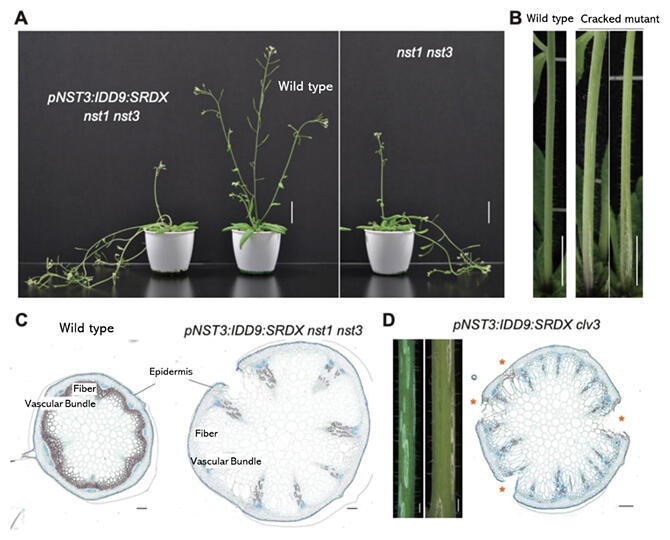A research group led by Associate Professor Ali Ferjani of Tokyo Gakugei University, Deputy Research Director Nobutaka Mitsuda of the National Institute of Advanced Industrial Science and Technology, Professor Hirokazu Tsukaya of the University of Tokyo, Professor Shinichiro Sawa of Kumamoto University and Professor Olivier Hamant of INRAE Lyon, France, have researched the mechanical role of the vascular tissue inside the stem during plant stem growth. Their extensive screening led to the discovery of a new lineage in which stem cracking occurs.

(B) Photograph of stem cracks.
(C) Microscopic image of a transverse section of a stem. Fiber cells are stained red in the wild type. In vascular bundles, they are mixed with ducts.
(D) Microscopic images of stem cracks and transverse sections of pNST3:IDD9:SRDX clv3 lines.
Provided by Tokyo Gakugei University
For this lineage, the researchers conducted a detailed analysis of the morphology of each cell in the internal stem tissue and noted the importance of the arrangement of vascular bundles in the stem interior. Stems are a characteristic structure of terrestrial plants that stand upright against gravity, flower and bear fruit.
Rare stem or trunk cracks that occur during growth have a serious negative impact on the growth and commercial value of crops and trees.
The interior of the stem is packed with a diverse range of cells, including ducts, sieve tubes, meristematic tissue and fibres. It has been a great mystery as to how the stem can maintain its integrity without cracking. The research group focused on a group of Arabidopsis mutants that produce stem cracks to understand stem morphogenesis.
In their study, they identified the pNST3:IDD9:SRDX phenotype, which produces cracks in the stem, through their own selection method.
Using this new phenotype as material, along with using various other mutants, their analysis strongly suggested that the number and arrangement of vascular bundles are important factors supporting the mechanical optimization of the stem, and that cracking occurs when the balance between the many different tissues that make up the stem is disrupted.
"In the future, we would like to deepen our understanding of the morphogenetic processes of plant stems and tree trunks through the analysis of cracks, which can be seen as accidents during the growth process, and also to develop technologies to prevent stem and trunk cracks from occurring," explained Ferjani.
This article has been translated by JST with permission from The Science News Ltd. (https://sci-news.co.jp/). Unauthorized reproduction of the article and photographs is prohibited.




